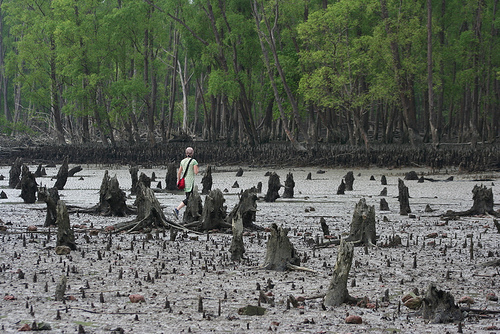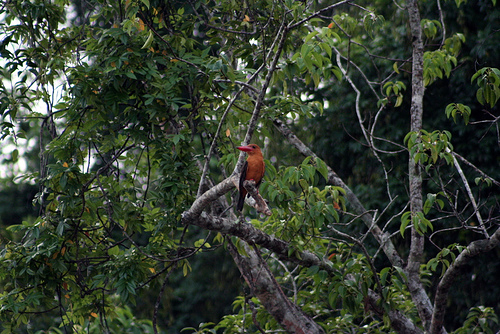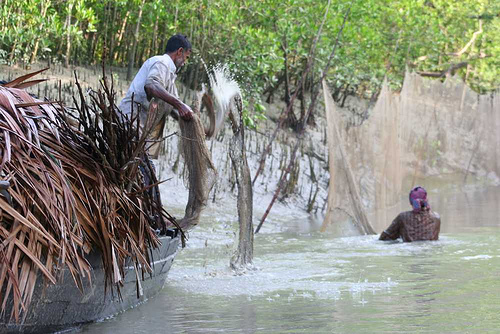The mangrove belts of Sundarbans expand from India till Bangladesh. Here, the border between land and water hazes away. It is a place where the ocean and rivers embrace each other and give aquatic life forms a perfect spot to thrive and create young ones. Terrestrial forms like the Royal Bengal Tiger have ample area to lead their solitary life, hunt, hide and stay away from the curious and sometimes irritating two legged humans. But human are rapidly encroaching this ideal habitat. Coasts are receding, mangroves are vanishing. So much so that experts say, the Sundarbans forests may soon become a thing of the past.
According to two separate studies conducted by the Zoological Society of London (ZSL) this month and the International Union for Conservation of Nature (IUCN) in December last year, the Sundarbans ecosystem is rapidly changing. A report published on 11th January in Remote Sensing by scientists from the ZSL states that as human development thrives, and global temperature continues to rise, as much as 200m of coast is disappearing in a single year at the Sundarbans.
Natural Barrier
Apart from being home to many animals, the Sundarbans acts as a natural border or wall for India and Bangladesh against huge tidal waves, sea cyclones, and tsunamis. The vanishing coast line could therefore bring catastrophic changes, taking with itself entire villages and towns.
ZSL’s Dr Nathalie Pettorelli, senior author of the paper says, “Our results indicate a rapidly retreating coastline that cannot be accounted for by the regular dynamics of the Sundarbans. Degradation is happening fast, weakening this natural shield for India and Bangladesh.”
The Sundarbans is the largest block of continuous mangrove forests in the world. It is inhabited by at least 500 different species of fishes, mammals, birds and reptiles. It is also home to mega predator the Royal Bengal Tiger, whose presence in the world is already threatened. This habitat is actually one of the few forests remaining that can hold many tigers at once.
Sarah Christie, ZSL’s tiger conservation expert says, “The Sundarbans is a critical tiger habitat; one of only a handful of remaining forests big enough to hold several hundred tigers. To lose the Sundarbans would be to move a step closer to the extinction of these majestic animals.”
Another impact of depleting mangrove forest will be on global warming. Mangroves represent less that 1 percent of forests in the world, but they have a huge impact on the climate. They are the most carbon rich forests in the tropics with high carbon capturing potential. Hence, their degradation and loss substantially reduce our ability to diminish, and adapt to, predicted changes in climatic conditions.
Human Pressure
The study conducted by the International Union for Conservation of Nature (IUCN) also says that the Indian side of Sundarbans is being subjected to various anthropogenic and natural processes affecting the distribution, quality and diversity of its mangroves.
What this means is that because of human inhabitation, wetland filling for construction purposes, brick kilns, farmlands etc. the quality and diversity of Sundarban forests is deteriorating.
“Human pressures and ecosystem changes are combining to threaten the population of endangered Royal Bengal tigers, one of the iconic species of the Sundarbans,” says the report titled ‘Sharing Lessons on Mangrove Restoration’.
The Sundarbans, cover 10,000 sq kms of land and water. Currently, over 4.2 million people live on the fringes of the Indian Sundarbans. The IUCN report points to human made problems that are leading to the death of these forests. These are,
- Climate change
- Illegial felling
- Poaching
- Blocking Freswater flow
- Unplanned embankments for settlements
The report also points out that in many places, sea water has replaced freshwater because of which plants such as the freshwater-loving Heritiera fomes cannot survive. The central part of the Indian Sundarbans receives almost no fresh water because of heavy siltation and clogging of the Bidyadhari channel.
“Seawater intrusion has further affected the growth of dominant mangrove species such as the freshwater-loving Heritiera fomes. The influence of salinity and effects of climate change, though not well-understood, appear to be promoting the invasion of alien species in some parts of the Sundarbans,” the report adds.
Fast Solutions
ZSL’s Chief Mangrove Scientific Advisor Jurgenne Primavera says: “Mangrove protection is urgent given the continuing threats to the world’s remaining 14 to 15 million hectares of mangroves from aquaculture, land development and over-exploitation. The recently established IUCN SSC Mangrove Specialist Group, hosted by ZSL, will develop a global conservation strategy for mangroves based on an assessment of research and conservation needs.”
It is simple to understand that the mangrove forests bordering India and Bangladesh have a role in safeguarding the topography as well as the lives of many plants and animals including humans. What is called today a beautiful forest (Sundarbans literally means Sundar – Beautiful Bans – Forest in Hindi) is increasingly becoming a wrinkled image of its past all because of hasty human malpractices. If not for the ecological benefit, at least for the selfish motive of protecting our own future, these forests need to Get Well Soon.
More Related Stories,
Researchers Find Rare Plants after 161 Species
How Mumbai Mangroves Save the City Everyday
Images via CC/Flickr by Frances Voon 1, 2













Hello,
Received your mail.It is a pity to know about the birds,the Sunderbans.As I had been there and really liked that Sanctuary a lot.It is different from the other Wildlife Sancturies.Hope the local people and forest Dept try to save that place.The birds too must be protected,and stopped from changing the place.I really wish I can do some thing to protect the wildlife.Cant the climate changes be improved.by having less traffic that spoils the nature.Having factories near the Sanctury.
Regards,
M.V.Bopardikar.
It is great to know that you visited Sunderbans. They are indeed nature’s marvel that we need to preserve. Climate change is a man-made problem and each one of us has the responsibility to tackle this problem. By using lesser fossil fuels, swithcing off lights/electric appliances we can do our bit. It is not an option, but mandatory if we want birds, animals and humans to exist the same way that they have been doing in the past.